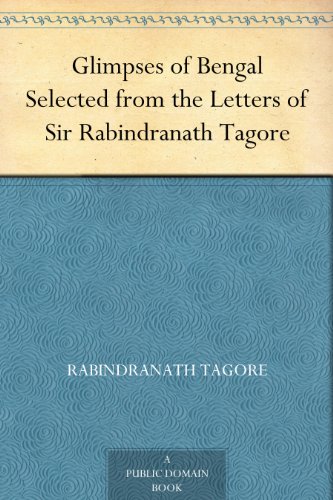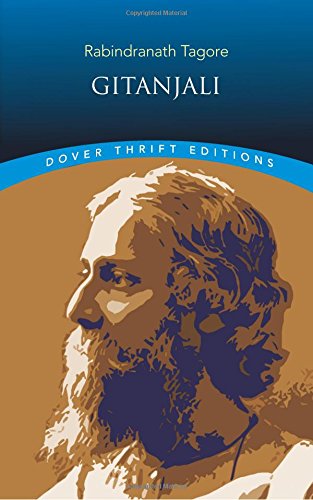-
The King of the Dark Chamber
Rabindranath Tagore
eBookNone
-
The Hungry Stones and Other Stories
Rabindranath Tagore
eBookThis book was converted from its physical edition to the digital format by a community of volunteers. You may find it for free on the web. Purchase of the Kindle edition includes wireless delivery.
-
Glimpses of Bengal Selected from the Letters of Sir Rabindranath Tagore
Rabindranath Tagore
eBookThis book was converted from its physical edition to the digital format by a community of volunteers. You may find it for free on the web. Purchase of the Kindle edition includes wireless delivery.
-
Gitanjali
Rabindranath Tagore
language (, May 17, 2012)This book was converted from its physical edition to the digital format by a community of volunteers. You may find it for free on the web. Purchase of the Kindle edition includes wireless delivery.
-
Gitanjali
Rabindranath Tagore
Paperback (Dover Publications, Nov. 30, 2011)A Bengali poet and mystic, Rabindranath Tagore (1861–1941) had long been loved and admired in India, but it was not until the publication of his own English translation of more than a hundred of his Bengali poems in 1913 that he achieved international fame — and a Nobel Prize. Comprised of moving, heartfelt prose poems reminiscent of Blake and Gibran — many almost biblical in their rhythms, phrasings, and images — Gitanjali (Song Offerings) was inspired by medieval Indian lyrics of devotion in which the principal subject is love, through some poems detail the internal conflict between spiritual longings and earthly desires, and others depict images drawn from nature.In his introduction to this translation, William Butler Yeats writes: "I have carried the manuscript of these translations about with me for days and I have often had to close it lest some stranger would see how much it moved me." This new edition is sure to earn Tagore a broad new following.
-
Gitanjali
Rabindranath Tagore
Paperback (Independently published, Jan. 3, 2020)Gitanjali is a collection of poems by the Bengali poet Rabindranath Tagore. Tagore received the Nobel Prize for Literature, largely for the English translation, Song Offering. It is part of the UNESCO Collection of Representative Works. Its central theme is devotion & motto is 'I am here to sing thee songs '.
-
The Crescent Moon: Illustrated
Rabindranath Tagore
Paperback (CreateSpace Independent Publishing Platform, Dec. 12, 2016)This is a wonderful collection of lyrical poetry and poetry in prose by India's most well-known poet, Rabindranath Tagore, whose book Gitanjali shot him to fame in the west. Originally written in Bengali, the poet himself translated the book into English. Most of the poems in The Crescent Moon focus on the love in a mother-child relationship and its development over the years as the child grows up, with a lot of nature imagery sprinkled in the verses. Tagore is an artist of rare lyrical powers, who understands the human soul. Tagore's poems and stories are devotions, mystical, sublimated ecstasy. They are the thoughts of a seer, the perfect union of beauty and truth. Rabindranath Tagore was a Nobel Laureate for Literature (1913) as well as one of India’s greatest poets and the composer of independent India’s national anthem, as well as that of Bangladesh. He wrote successfully in all literary genres, but was first and foremost a poet, publishing more than 50 volumes of poetry. He was a Bengali writer who was born in Calcutta and later traveled around the world. W
W
-
Gitanjali
Rabindranath Tagore, W. B. Yeats
Paperback (Digireads.com Publishing, Dec. 27, 2019)First published in English in 1912, “Gitanjali”, or “Song Offerings”, is a collection of poems translated by the author, Rabindranath Tagore, from the original Bengali. It contains over 100 inspirational poems by India’s greatest poet and earned Tagore the Nobel Prize for Literature in 1913. Tagore, known as the “Bard of Bengal”, was born in 1861 to a wealthy family and started writing poetry as a child and began publishing critically acclaimed verses as a teenager. Tagore went on to write novels, stories, and dramas, work which would reshape Bengali literature and culture. He first published the “Gitanjali” collection of poems, widely considered to be one of his best works, in his native Bengali language in 1911. The original Bengali version contained over 150 verses and many were combined or edited out when Tagore translated them into English. Deeply spiritual and devotional, Tagore’s poems are primarily concerned with love and the conflict between earthly desires and spiritual passions and longings. Tagore also spoke eloquently and movingly of his connection to the natural world. This volume includes the introduction by William Butler Yeats that accompanied the original 1912 English language version. This edition is printed on premium acid-free paper.
-
Gitanjali:
Rabindranath Tagore
language (JKL Classics, Jan. 1, 2018)"While traveling through one of the poorest regions in India, W. B. Yeats was amazed to discover the women in the tea fields singing the songs and poems of Rabindranath Tagore. This striking scene led the great Irish poet to appreciate the depth of India's far-reaching tradition of poetry and the fame of this one Indian poet. Tagore's work is without equal and
-
Gitanjali
Rabindranath Tagore, GP Editors
eBook (GENERAL PRESS, )None
-
GITANJALI:
Rabindranath Tagore, Deni Debnath
eBook (, May 4, 2017)Gitanjali (Bengali: গীতাঞ্জলি) is a collection of poems by the Bengali poet Rabindranath Tagore. Tagore recivied the Nobel Prize for Literature, largely for the book. The original Bengali collection of 157 poems was published on August 14, 1910. The English Gitanjali or Song Offerings is a collection of 103 English poems of Tagore's own English translations of his Bengali poems first published in November 1912 by the India Society of London. It contained translations of 53 poems from the original Bengali Gitanjali, as well as 50 other poems which were from his drama Achalayatan and eight other books of poetry — mainly Gitimalya (17 poems), Naivedya (15 poems) and Kheya (11 poems)
-
The Complete Works of Rabindranath Tagore
Rabindranath Tagore, GP Editors
eBook (GENERAL PRESS, Feb. 22, 2017)The Works of Rabindranath Tagore consist of poems, novels, short stories, dramas, and essays that Bengali poet and Brahmo philosopher Rabindranath Tagore created over his lifetime. This ebook presents a collection of all major works of Tagore. A dynamic table of contents allows you to jump directly to the work selected.Tagore's literary reputation is disproportionately influenced very much by regard for his poetry; however, he also wrote novels, essays, short stories, travelogues, dramas, and thousands of songs. The poems of Rabindranath Tagore are among the most haunting and tender in Indian and in world literature, expressing a profound and passionate human yearning. His ceaselessly inventive works deal with such subjects as the interplay between God and the world, the eternal and transient, and with the paradox of an endlessly changing universe that is in tune with unchanging harmonies. Poems such as 'Earth' and 'In the Eyes of a Peacock' present a picture of natural processes unaffected by human concerns, while others, as in 'Recovery 14', convey the poet's bewilderment about his place in the world. Tagore introduced new prose and verse forms and the use of colloquial language into Bengali literature, thereby freeing it from traditional models based on classical Sanskrit. He was highly influential in introducing the best of Indian culture to the West and vice versa, and he is generally regarded as the outstanding creative artist of modern South Asia.RABINDRANATH TAGORE:Rabindranath Tagore (1861-1941) was the youngest son of Debendranath Tagore, a leader of the Brahmo Samaj. He was educated at home and although at seventeen he was sent to England for formal schooling, he did not finish his studies there. In his mature years, in addition to his many-sided literary activities, he managed the family estates, a project which brought him into close touch with common humanity and increased his interest in social reforms. He also started an experimental school at Shantiniketan where he tried his Upanishadic ideals of education. From time to time he participated in the Indian nationalist movement, though in his own non-sentimental and visionary way; and Gandhi, the political father of modern India, was his devoted friend. Tagore was knighted by the ruling British Government in 1915, but within a few years he resigned the honour as a protest against British policies in India.Tagore had early success as a writer in his native Bengal. With his translations of some of his poems he became rapidly known in the West. In fact, his fame attained a luminous height, taking him across continents on lecture tours and tours of friendship. For the world he became the voice of India's spiritual heritage; and for India, especially for Bengal, he became a great living institution.Although, Tagore wrote successfully in all literary genres, he was first of all a poet. Among his fifty and odd volumes of poetry are Manasi (1890) , Sonar Tari (1894) , Gitanjali (1910) , Gitimalya (1914) , and Balaka (1916) . The English renderings of his poetry, which include The Gardener (1913), Fruit-Gathering (1916), and The Fugitive (1921), do not generally correspond to particular volumes in the original Bengali; and in spite of its title, Gitanjali: Song Offerings (1912), the most acclaimed of them, contains poems from other works besides its namesake. Tagore’s major plays are Raja (1910) , Dakghar (1912) , Achalayatan (1912) , Muktadhara (1922) , and Raktakaravi (1926) . He is the author of several volumes of short stories and a number of novels, among them Gora (1910), Ghare-Baire (1916) , and Yogayog (1929) . Besides these, he wrote musical dramas, dance dramas, essays of all types, travel diaries, and two autobiographies, one in his middle